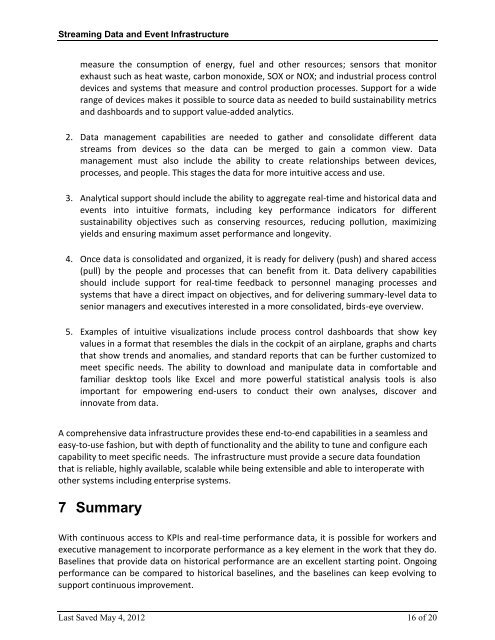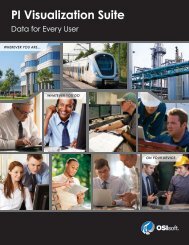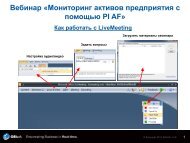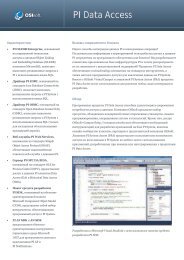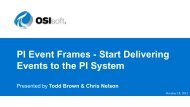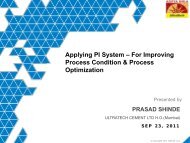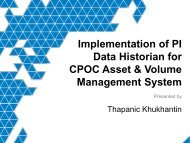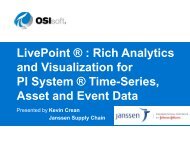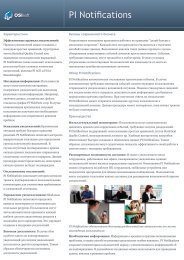Streaming Data and Event Infrastructure - OSIsoft
Streaming Data and Event Infrastructure - OSIsoft
Streaming Data and Event Infrastructure - OSIsoft
You also want an ePaper? Increase the reach of your titles
YUMPU automatically turns print PDFs into web optimized ePapers that Google loves.
<strong>Streaming</strong> <strong>Data</strong> <strong>and</strong> <strong>Event</strong> <strong>Infrastructure</strong><br />
measure the consumption of energy, fuel <strong>and</strong> other resources; sensors that monitor<br />
exhaust such as heat waste, carbon monoxide, SOX or NOX; <strong>and</strong> industrial process control<br />
devices <strong>and</strong> systems that measure <strong>and</strong> control production processes. Support for a wide<br />
range of devices makes it possible to source data as needed to build sustainability metrics<br />
<strong>and</strong> dashboards <strong>and</strong> to support value-added analytics.<br />
2. <strong>Data</strong> management capabilities are needed to gather <strong>and</strong> consolidate different data<br />
streams from devices so the data can be merged to gain a common view. <strong>Data</strong><br />
management must also include the ability to create relationships between devices,<br />
processes, <strong>and</strong> people. This stages the data for more intuitive access <strong>and</strong> use.<br />
3. Analytical support should include the ability to aggregate real-time <strong>and</strong> historical data <strong>and</strong><br />
events into intuitive formats, including key performance indicators for different<br />
sustainability objectives such as conserving resources, reducing pollution, maximizing<br />
yields <strong>and</strong> ensuring maximum asset performance <strong>and</strong> longevity.<br />
4. Once data is consolidated <strong>and</strong> organized, it is ready for delivery (push) <strong>and</strong> shared access<br />
(pull) by the people <strong>and</strong> processes that can benefit from it. <strong>Data</strong> delivery capabilities<br />
should include support for real-time feedback to personnel managing processes <strong>and</strong><br />
systems that have a direct impact on objectives, <strong>and</strong> for delivering summary-level data to<br />
senior managers <strong>and</strong> executives interested in a more consolidated, birds-eye overview.<br />
5. Examples of intuitive visualizations include process control dashboards that show key<br />
values in a format that resembles the dials in the cockpit of an airplane, graphs <strong>and</strong> charts<br />
that show trends <strong>and</strong> anomalies, <strong>and</strong> st<strong>and</strong>ard reports that can be further customized to<br />
meet specific needs. The ability to download <strong>and</strong> manipulate data in comfortable <strong>and</strong><br />
familiar desktop tools like Excel <strong>and</strong> more powerful statistical analysis tools is also<br />
important for empowering end-users to conduct their own analyses, discover <strong>and</strong><br />
innovate from data.<br />
A comprehensive data infrastructure provides these end-to-end capabilities in a seamless <strong>and</strong><br />
easy-to-use fashion, but with depth of functionality <strong>and</strong> the ability to tune <strong>and</strong> configure each<br />
capability to meet specific needs. The infrastructure must provide a secure data foundation<br />
that is reliable, highly available, scalable while being extensible <strong>and</strong> able to interoperate with<br />
other systems including enterprise systems.<br />
7 Summary<br />
With continuous access to KPIs <strong>and</strong> real-time performance data, it is possible for workers <strong>and</strong><br />
executive management to incorporate performance as a key element in the work that they do.<br />
Baselines that provide data on historical performance are an excellent starting point. Ongoing<br />
performance can be compared to historical baselines, <strong>and</strong> the baselines can keep evolving to<br />
support continuous improvement.<br />
Last Saved May 4, 2012 16 of 20


